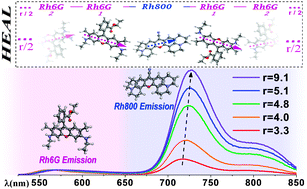J.R. Sánchez-Valencia, F.J. Aparicio, J.P. Espinós, A.R. González-Elipe, A. Barranco
Physical Chemistry Chemical Physics, 13 (2011) 7071–7082
doi: 10.1039/C0CP02421J

An enhanced fluorescent emission in the near infrared is observed when the Rhodamine 800 (Rh800) and 6G (Rh6G) dyes are coadsorbed in porous SiO2 optical thin films prepared by glancing angle deposition (GLAD). This unusual behavior is not observed in solution and it has been ascribed to the formation of a new type of J-heteroaggregates with enhanced acceptor luminescence (HEAL). This article describes in detail and explains the main features of this new phenomenology previously referred in a short communication [J. R. Sánchez-Valencia, J. Toudert, L. González-García, A. R. González-Elipe and A. Barranco, Chem. Commun., 2010, 46, 4372–4374]. It is found that the efficiency and characteristics of the energy transfer process are dependent on the Rh6G/Rh800 concentration ratio which can be easily controlled by varying the pH of the solutions used for the infiltration of the molecules or by thermal treatments. A simple model has been proposed to account for the observed enhanced acceptor luminescence in which the heteroaggregates order themselves according to a “head to tail” configuration due to the geometrical constrains imposed by the SiO2 porous matrix thin film. The thermal stability of the dye molecules within the films and basic optical (absorption and fluorescence) principles of the HEAL process are also described.

